|
|
|
Sort Order |
|
|
|
Items / Page
|
|
|
|
|
|
|
| Srl | Item |
| 1 |
ID:
068512


|
|
|
| 2 |
ID:
123275
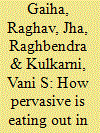

|
|
|
|
|
| Publication |
2013.
|
| Summary/Abstract |
A key feature of India's economic transformation has been a change in the nature of diets. There is a move away from inferior to superior foods and a substitution of traditional staples by primary food products, reflected in higher consumption of proteins, sugars, fats and vegetables. As part of this dietary transition, our analysis focuses on the pervasiveness of eating out and is based on a rich household survey for 2005. We broadly confirm the important role of urbanization, demographic changes, expansion of the middle class and its growing affluence on eating out. Since even more deprived sections are not immune to these evolving dietary patterns and given their limited access to medical care, health outcomes may well be grim.
|
|
|
|
|
|
|
|
|
|
|
|
|
|
|
|
| 3 |
ID:
097137
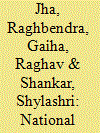

|
|
|
|
|
| Publication |
2010.
|
| Summary/Abstract |
This paper presents results on the participation of rural workers in the National Rural Employment Guarantee Programme based on a pilot survey of three villages in the Chittoor district, Andhra Pradesh (AP), India. These villages are Kaligiri, Obulayyapale and Reddivaripalle, and they were surveyed in December 2007. In contrast to an earlier study of ours on Rajasthan, Scheduled Castes (SCs) and Scheduled Tribes (STs) participated in higher numbers in AP, but in both states these groups participated for slightly lower spells than the residual group of 'Others'. We find that AP performed better than Rajasthan in terms of targeting poorer caste and income groups such as SCs, STs and landless households. The number of days worked on average was much higher than suggested by other assessments. Our econometric analysis further reinforces the view that disadvantaged groups are not only more likely to participate but also for longer spells. Thus the performance of the National Rural Employment Guarantee Programme has been far from dismal.
|
|
|
|
|
|
|
|
|
|
|
|
|
|
|
|
| 4 |
ID:
131244
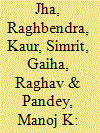

|
|
|
|
|
| Publication |
2014.
|
| Summary/Abstract |
The workfare scheme, the National Rural Employment Guarantee Scheme (NREGS), and the direct food subsidy programme, the Targeted Public Distribution Scheme (TPDS), represent two social safety nets instituted in India as anti-poverty measures. This paper examines whether from the point of view of individual households the two programmes are substitutes or complements, as this will shed light on the appropriateness of the design of the two programmes. Based on primary household data collected for the Indian states of Rajasthan and Madhya Pradesh (MP), we show that, in Rajasthan, a large percentage of households consider TPDS and NREGS programmes to be substitutes for each other, while in MP the households often perceive the two programmes as complements. Thus it appears that the two programmes are better designed in MP since an incentive for participation in one programme has desirable side effects on participation in the other. Correlates of participation in the two states are identified and the paper advances several policy conclusions.
|
|
|
|
|
|
|
|
|
|
|
|
|
|
|
|
| 5 |
ID:
101497
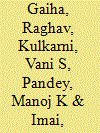

|
|
|
|
|
| Publication |
2010.
|
| Summary/Abstract |
The objective of this analysis is mainly to construct an intuitive measure of the performance of the National Rural Employment Guarantee Scheme (NREGS) in India. The focus is on divergence between demand and supply at the district level. Some related issues addressed are: (i) whether the gap between demand and supply responds to poverty; and (ii) whether recent hikes in NREGS wages are inflationary. Our analysis confirms responsiveness of the positive gap between demand and supply to poverty. Also, apprehensions expressed about the inflationary potential of recent hikes in NREGS wages have been confirmed. More importantly, higher NREGS wages are likely to undermine self-selection of the poor in it.
|
|
|
|
|
|
|
|
|
|
|
|
|
|
|
|
| 6 |
ID:
110818
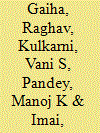

|
|
|
|
|
| Publication |
2012.
|
| Summary/Abstract |
Despite accelerated growth there is pervasive hunger, child undernutrition and mortality in India. Our analysis focuses on their determinants. Raising living standards alone will not reduce hunger and undernutrition. Reduction of rural/urban disparities, income inequality, consumer price stabilization, and mothers' literacy all have roles of varying importance in different nutrition indicators. Somewhat surprisingly, public distribution system (PDS) do not have a significant effect on any of them. Generally, child undernutrition and mortality rise with poverty. Our analysis confirms that media exposure triggers public action, and helps avert child undernutrition and mortality. Drastic reduction of economic inequality is in fact key to averting child mortality, conditional upon a drastic reordering of social and economic arrangements.
|
|
|
|
|
|
|
|
|
|
|
|
|
|
|
|
|
|
|
|
|